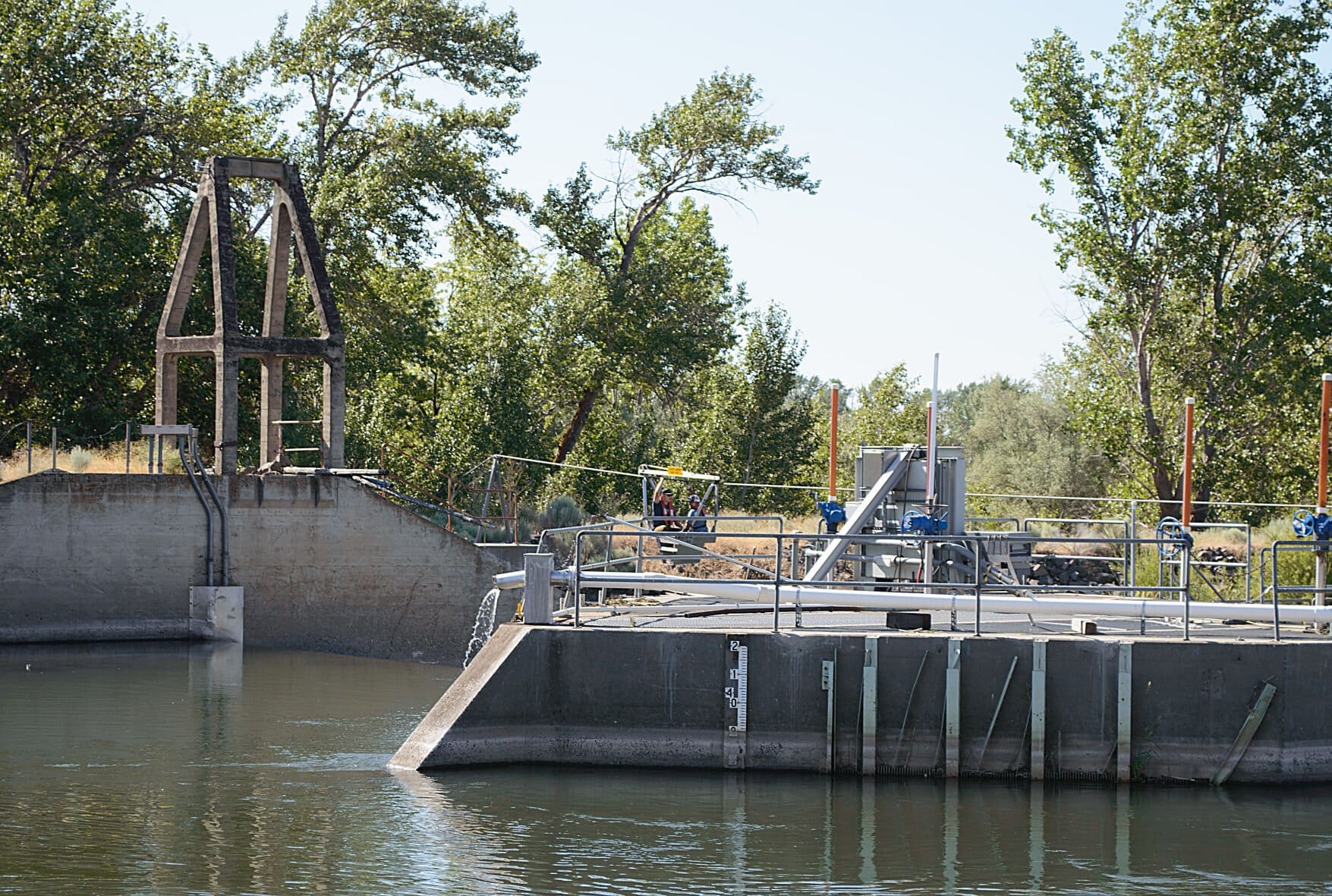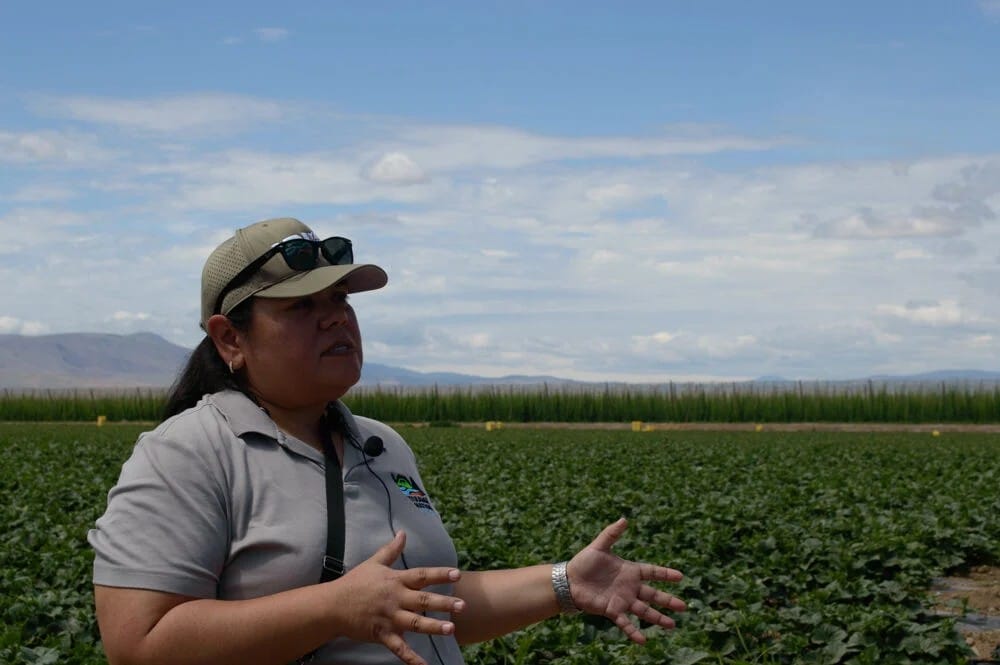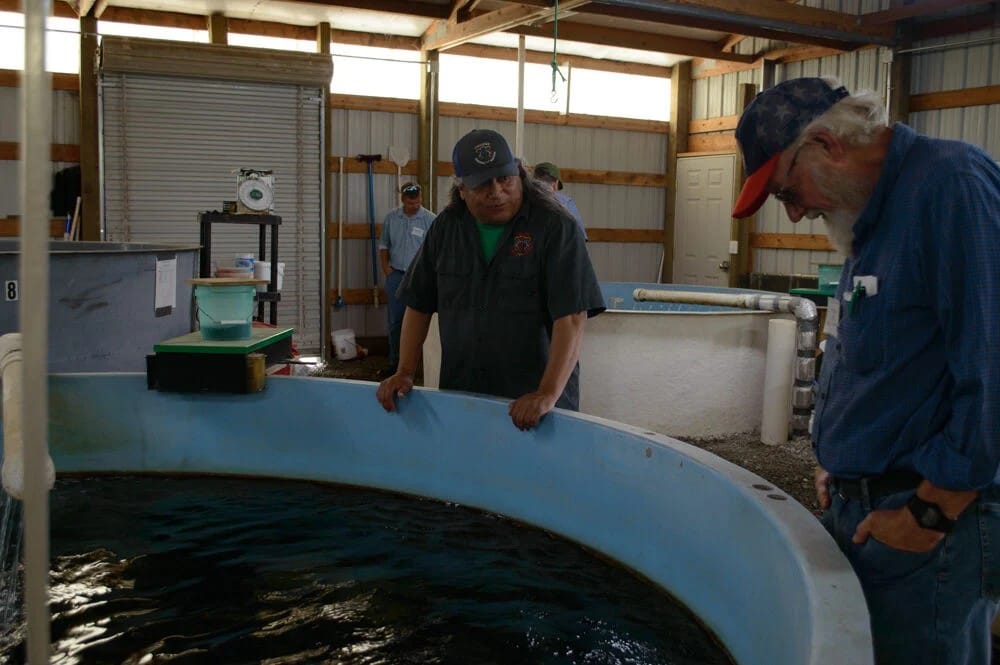This article originally appeared in the Yakima Herald-Republic.
Water rushes into the headgates of the 107-year-old Wapato Diversion Dam on the Yakima River, south of Union Gap. With it go fish.
The dam pulls in water, up to 2,200 cubic feet per second, for the Wapato Irrigation Project, the largest irrigation project in the Yakima basin. It supplies water to 140,000 acres on the Yakama Reservation, including some key projects that the Yakama Nation uses to provide food to its citizens.
The structure has been renovated over the years; a fish drum screen diverts fish away from the irrigation canals and back into the river.
But the concrete design, full of straight lines and fast flows, leaves much to be desired when it comes to reducing fish mortality. It’s like the fish are being sent through a washing machine, said Tom Elliot, project manager for Yakama Nation Fisheries.
The Bureau of Indian Affairs and Yakama Nation are mulling over two designs which aim to reduce fish mortality at the site and fix other structural issues.
The site was one of several stops along a tour last week of the Wapato Irrigation Project organized by the Yakima Basin Joint Board, a partnership among seven irrigation districts and the city of Yakima. It supports the Yakima Basin Integrated Plan, which works to resolve water issues among otherwise competing interests.
The upgrades would extend the lifespan of a facility critical to the Yakama’s economic development while also providing safer passage for fish.
In need of improvements
The Wapato dam was built in 1917 by the Bureau of Indian Affairs for the reservation during a time of forced cultural assimilation. It has diversion structures on the east and west channels of the Yakima River.
The new designs also consider how to reduce sediment buildup and flood risk, as well as provide for worker safety with access bridges across the Yakima River.

The first design plan, the “preliminary preferred alternative,” would keep the facility mostly as-is, with some important improvements like replacing the undershot gate with either slide gates or split-leaf gates. That would help reduce fish mortality and allow diversion at lower flows.
Its estimated cost is $105 million.
The second plan, the “alternative concept,” is a more expensive option. It would involve putting a fish screen at the start of the west channel, which would prevent fish from getting into the headgates. The estimated cost is $245 million.
Both are currently being considered by the BIA and Yakama Nation. A preliminary timeline estimates construction starting around 2031, but that depends on federal funding, Elliot said.
The dam is one of many along the river which ushered in a century of irrigated agriculture and development to the basin, attracting settlers to the Yakima Valley.
The damming of the Columbia and Yakama rivers for irrigation and cheap hydropower blocked the movement of culturally important species like salmon, sturgeon and Pacific lamprey. In the latter half of the 20th century, when the impact of dams became more widely understood, fish ladders and screens began to be added. It was not enough.
Adult steelhead and salmon are able to pass the diversion using the fish ladders, but young salmon, bull trout and Pacific lamprey have a much more difficult time getting through.
A 2023 Bureau of Reclamation report said that at the Wapato dam, fishing access for tribal citizens is restricted to the east bank of the east branch of the river, below the diversion.
Blodgett said he remembers that when he was a kid it was still an important area for subsistence fishing.
Many species would likely have disappeared if not for the Yakama Nation’s fisheries program, which spawns fish and transports them around blockages.
It has long been the Yakama Nation’s goal to get native fish stock back to sustainable and harvestable levels, said Joe Blodgett, project manager with Yakama Nation Fisheries.
The Wapato dam is one of multiple dams in the sights of the Yakima Basin Integrated Plan, a collaboration of local, state, federal and tribal organizations to address water needs and provide for the safe passage of fish. Recent projects included the removal of the Nelson low head dam and the construction of a massive fish passage system at Cle Elum Reservoir.
Redefining what agriculture means
One Yakama Nation agricultural program that relies on the diversion lies just southeast of Harrah, at Yakima Nation Farms. In 2021 the Yakama Nation purchased a 1,500-acre produce farm from the Inabas, a family who had long farmed in the Lower Yakima Valley.
“We know the importance of diverting water. We’re farmers too,” Blodgett said.

Jonalee Squeochs spoke excitedly about the new venture for the Yakama while standing in a field of cucumbers.
Squeochs grew up down the road on a neighboring farm with cattle, horses and hay, so when a position opened there, it seemed like destiny.
Squeochs said that the 14 Confederated Bands and Tribes of the Yakama Nation historically were not agriculturalists, and the purchase of the farm was a strategic move to increase tribal food sovereignty and security.
“We’ve had elders tell us that we cannot be a sovereign nation if we don’t have the ability to feed ourselves,” Squeochs said.
The farm has given away thousands of boxes of free produce to tribal members, with the help of a USDA grant. It also supplies food to Northwest Harvest and Second Harvest, which distribute food around the region.
The birth of Yakima Nation Farms was also important for new economic development.
“We’re now part of the food chain of the West Coast,” Squeochs said, with Yakama Nation Farms produce shipping from Canada to California.
The farm grows about 20 different crops, including asparagus, corn, zucchini and watermelon. Around 500 acres of the farm is organic.
Sweet corn and watermelon are nearly ready for harvest. But Squeochs already has her mind on pumpkin and winter squash harvest in the fall.
Squeochs has many ambitions for the development of the farm, including expanding what they grow. Another area she is working on is expanding the retail side of the business, with plans to reopen the Yakama Nation's produce stand by Highway 97 across from the Wapato dam and start a new subscription produce box program.
The work is hard but important.
Squeochs said that Yakama Nation Farms is a chance to “redefine what agriculture means to the Yakama Nation.”
“This is the most fulfilling role I’ve had,” she said.
Sturgeon
Prehistoric-looking fish calmly swim in mismatched circles at a Yakima Nation Fisheries hatchery south of Harrah. White sturgeon, the largest freshwater fish in North America, have been grown there since the hatchery opened in 2009.
The program has been working to reverse the decline of the fish since the damming of the rivers.
The Grant Public Utility District is the Yakama Nation’s largest customer for the sturgeon, which purchases 3,250 of them every year so they can be released near Priest Rapids and Wanapum dam.

Another notable customer is Yakima’s James Beard Award-nominated restaurant Crafted, which usually has sturgeon in some form on the menu.
Breeding the fish is a careful, time-intensive process, said Tygh Schuster, biologist for Yakama Nation Fisheries.
Six pairs of fish are taken from the wild each year and kept for breeding. Sturgeon are used to turbulent water, and its eggs are extremely sticky. They must be extracted and kept dry while they work to mix the eggs with milt.
The fisheries program also offers free fish for tribal member funerals.
There is also hope to revive the tribe’s caviar brand, Celilo Select. The eggs are harvested from the largest and oldest of the fish, Schuster said.
Questen Inghram is a WSU Murrow News Fellow based at the Yakima Herald-Republic, which originally published this article on July 6, 2025.

